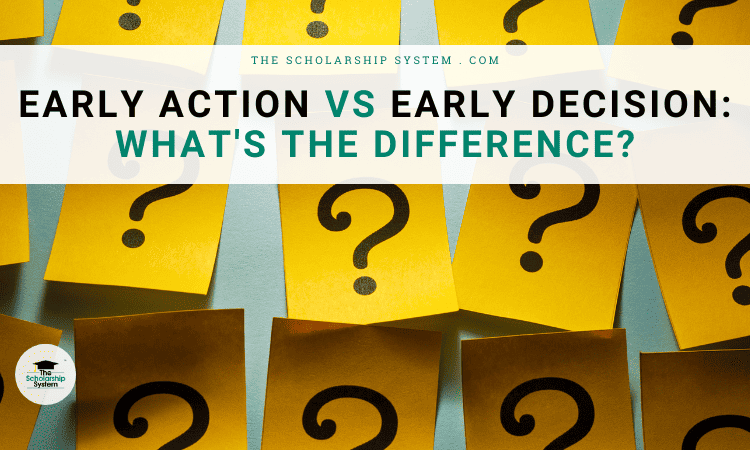Updated on July 4th, 2023
Many colleges and universities offer students the ability to apply for admission through early action and early decision programs. While the application process is similar to what students experience with regular admissions, they come with unique benefits. However, there are also some caveats to consider when comparing early action vs. early decision, and understanding what they are is critical.
Whether your student applies for early action or early decision, scholarships can help them earn their degree debt-free. If you and your student want to learn more about where to find scholarships to make college more affordable, sign up for our free college scholarship webinar! Take a trip over to http://thescholarshipsystem.com/freewebinar to reserve your spot today.
Fortunately, seeing how early action and early decision stand apart is relatively simple, as the differences are distinct. Here’s a look at early action vs. early decision, including why they’re beneficial, what they involve, how they differ, and more.
Contents
- 1 Why Is It Important to Apply Early to Colleges?
- 2 What Is Early Action Admission?
- 3 What Is Early Decision Admission?
- 4 Early Decision vs. Early Action: Similarities and Differences
- 5 Early Action vs. Early Decision: Pros and Cons
- 6 Early Action Pros and Cons
- 7 Early Decision Pros and Cons
- 8 When Are Early Action and Early Decision Deadlines?
- 9 Early Action and Early Decision FAQs
- 9.1 Does Early Application Increase Your Chance of Admission?
- 9.2 Are All Early Decision Applications the Same?
- 9.3 Is Early Action Better Than Early Decision?
- 9.4 Do Colleges Prefer Early Decision or Early Action?
- 9.5 Is It Harder to Get Accepted with Early Action?
- 9.6 What Is the Difference Between Early Action and Regular Action?
- 9.7 Can You Back Out of Early Action?
- 9.8 Does Early Decision Raise Your Chances or Hurt Your Chances?
- 9.9 Is Early Admission the Same as Early Decision?
Why Is It Important to Apply Early to Colleges?
Applying to college early often works in a student’s favor if they know the school they’d like to attend, particularly if competition for spots in the incoming class is fierce. Early applications show the college that the student is enthusiastic about going to that institution and a clear demonstration of interest can benefit students.
Plus, applying early allows students to submit their information before those who wait for regular admissions. As a result, early applicants typically face a little less competition, which is helpful if the college admissions process is highly competitive.
With early admission processes, students also receive a decision sooner, which can give them peace of mind if they’re accepted and allow them to end their college search faster. Plus, if they aren’t admitted, they have enough time to shift to plan B without worrying that they’ll run out of time.
What Is Early Action Admission?
Early action is a non-binding admissions option that allows students to submit applications in the fall (with deadlines usually falling in late October or early November) and receive decisions in the winter, typically no later than February. Essentially, it’s a program that accelerates the college admission process for students, allowing them to find out if they’re accepted to their top choice schools sooner than if they wait for regular admissions.
Since early action is non-binding, students can opt not to attend a college that admits them. As a result, students can apply to multiple colleges during the early action time of the year, giving them a chance to explore numerous options – such as evaluating financial aid packages and other details – and still complete their college search in advance.
It is critical to note that some colleges have early action-restrictive programs. With these, students can only apply to one school during the early action period. However, students aren’t obligated to attend if they’re admitted to that college, so they can continue exploring alternatives during the regular admissions period.
What Is Early Decision Admission?
Early decision is a binding admissions option where students submit an application to one school (usually their top choice college) and, when they do so, commit to attending if they’re accepted. As with early action, the deadline to apply is typically in late October or early November.
If accepted, students don’t have the option of exploring other colleges or choosing to attend another university. They’re functionally guaranteeing their attendance before they have a chance to see financial aid packages or similar details. However, using this approach may improve a student’s chance of admission, as it’s a definitive demonstration of genuine interest in a single college.
If a student isn’t accepted, their obligations end. They can explore other colleges during the regular admissions period without any negative recourse, so there’s usually plenty of time to transition to plan B.
Early Decision vs. Early Action: Similarities and Differences
Early action and early decision have plenty of aspects in common. Both have similar due dates, usually falling in late October or early November. Decisions are also made on applicants no later than February, with many schools providing that information in December or January.
In some cases, early decision and early action admissions processes can give a student a slight edge. Their application is evaluated before students start submitting their application during the regular admissions season, so there’s less competition. However, the benefit is typically minor at highly selective schools with large numbers of applicants, as even their early admissions processes can receive far more applications than their incoming class numbers can support.
Where the two stand apart is whether a student is obligated to attend. Early decision involves a commitment to a single school, with a student effectively promising they’ll attend if admitted. Early action doesn’t say admitted students have that obligation, so students are free to explore other options.
Additionally, early decision admissions only allow a student to apply at one school during the early admissions period. The same is true for early action-restrictive. However, traditional early action programs don’t limit the number of schools where students can apply, so they can submit multiple applications during the early admissions timeframe if they go that route.
Early Action vs. Early Decision: Pros and Cons
Both early action and early decision come with benefits and drawbacks. Some of the advantages and disadvantages are shared, while others are unique to the specific admissions program. Here is an overview of the early action vs. early decision pros and cons.
Early Action Pros and Cons
Pros:
- No obligation to enroll
- Admission decisions are issued no later than February
- Option to apply to multiple schools (aside from restrictive early action programs)
- Can assess financial aid packages before committing
- More time to prepare for a specific college if accepted
- Time to apply elsewhere if not accepted
Cons:
- While admissions odds are improved, the difference isn’t as always significant
Early Decision Pros and Cons
Pros:
- May reduce the entire college application process to a single application if the student is admitted
- Admission decisions are issued no later than February
- Potentially less competition, which could increase a student’s odds of acceptable
- More time to prepare for a specific college if accepted
- Time to apply elsewhere if not accepted
Cons:
- Obligated to enroll if accepted
- Can only apply to one school during early admissions (and not at all during regular admissions, if accepted), so it’s a high-pressure decision
- Can’t review financial aid packages before committing
When Are Early Action and Early Decision Deadlines?
Early action deadlines and early decision deadlines can vary from one school to the next. However, they primarily fall between late October and early November, and many choose November 1 as the deadline. But there are also schools that accept early action or early decision applications later, including as late as December 1.
Since the deadlines can vary from one school to the next, prospective students need to look at the admissions timeline for the specific school they want to attend. That way, they don’t assume an incorrect date applies, ensuring they’ll get their application submitted on time.
Early Action and Early Decision FAQs
Does Early Application Increase Your Chance of Admission?
An early application can potentially increase a student’s odds of acceptance. It’s a clear demonstration of interest, which works in students’ favor. Plus, there may be fewer applicants to compete against, which could make standing out easier.
However, highly competitive schools usually get a large number of early applicants. In that case, some of the advantages aren’t as big a part of the equation. Still, applying early comes with other benefits – including getting a decision sooner – so even if it doesn’t lead to a higher chance of admission, it’s worth considering.
Are All Early Decision Applications the Same?
Early decision applications are usually very similar, but they can vary a bit from one school to the next. Every college has its own priorities and considerations when selecting new students for admission. As a result, they may feature unique essay questions, document submission requirements, standardized test scores, or other details that different schools don’t use.
Is Early Action Better Than Early Decision?
Neither early action nor early decision is inherently better than the other. If a student is confident in their first-choice school and knows they’d want to attend if accepted, the restrictive nature of early decision isn’t as much of a concern.
However, if a student wants to factor in their financial aid package or is struggling to pick between multiple colleges, early action is potentially a better fit. It offers more flexibility since it’s non-binding, giving students a chance to keep the doors open.
Do Colleges Prefer Early Decision or Early Action?
Most colleges that classically secure enough incoming students to fill the available slots don’t have a distinct preference over early decision or early action applicants. However, early decision students may have a stronger chance of acceptance.
Typically, students who go that route have gone the extra mile to ensure they’re exceptional candidates for admission, and the restrictive nature of the program could mean less competition. Still, colleges may not favor one approach over the other, so students should choose the one that best meets their needs.
Is It Harder to Get Accepted with Early Action?
Typically, early action makes getting accepted at a school easier than if a student waits until the regular application period. There’s less competition during the early action phase, which can work in their favor. There’s also no difficulty difference between early action and early decision in the majority of cases.
What Is the Difference Between Early Action and Regular Action?
Early action is an application and college admission decision period that occurs early in the academic year than regular action. While early action applications are typically due between late October and early November (or potentially as late as early December), regular action applications aren’t due until sometime between early January and late February. Early action decisions usually come out between mid-December and February, while regular action admission decisions aren’t typically released until mid-March and into April.
Can You Back Out of Early Action?
Early action is non-binding. Students aren’t obligated to attend even if they’re selected for admission. Additionally, they often don’t have to formally confirm their attendance until May, giving them plenty of time to compare other options before choosing a college.
Does Early Decision Raise Your Chances or Hurt Your Chances?
Early decision usually either increases a student’s chances of admission or has no effect on their odds of admission. The only time when early decision applicants say it can have a negative impact is if a student would benefit from raising their SAT or ACT scores or improving their transcript during their senior year. Since early decision requires application materials no later than mid-November, any tests or grade improvements after the application is submitted aren’t considered during early decision, but they could factor in if a student waited to apply until the regular admissions season.
Is Early Admission the Same as Early Decision?
Early admission and early decision are similar but not the same. Early admission can include both early action and early decision admissions programs, as both occur before regular admissions season. In contrast, early decision is a specific, binding admissions option, so it’s less broad than early admissions.
Whether your student applies for early action or early decision, scholarships can help them earn their degree debt-free. If you and your student want to learn more about where to find scholarships to make college more affordable, sign up for our free college scholarship webinar! Take a trip over to http://thescholarshipsystem.com/freewebinar to reserve your spot today.









Leave a Reply